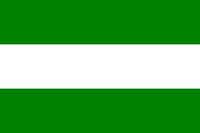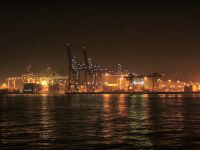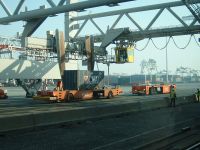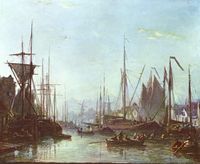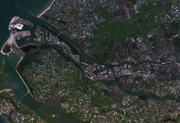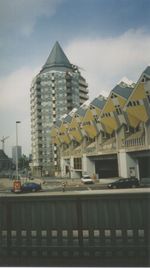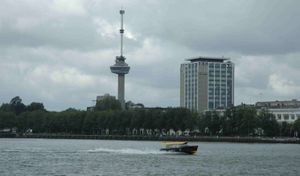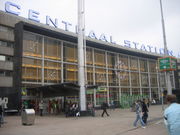Rotterdam
2007 Schools Wikipedia Selection. Related subjects: European Geography
- Location
- Coat of arms
 The coat of arms reads "Sterker door Strijd", i.e. "Stronger through Struggle".
The coat of arms reads "Sterker door Strijd", i.e. "Stronger through Struggle".
- Flag
- Country
- The Netherlands
- Province
- South Holland
- Population
- 588,718 (2006)
- Coordinates
- 51° 55' N.; 4° 30' E.
- Website
- www.rotterdam.nl
- Nickname
- - Maasstad ("Meuse Town/City", or "Town/City of the Meuse")
- - Rotjeknor (used in affection)
- - Manhattan aan de Maas ("Manhattan upon Meuse", referring not to the city as a whole but rather to the city centre, after its – by Dutch standards – large amount of skyscrapers)
- - 010 (after its area code; used predominantly in football-related rivalry by "020", i.e. Amsterdam)
- - Rotjeknor (used in affection)
- Mayor
- I.W. (Ivo) Opstelten
Rotterdam ( pronunciation ( help· info)) is, in terms of population, the second largest municipality in the Netherlands (after Amsterdam, the country's capital) and the largest city in the province of Zuid-Holland ( South Holland), the country's most populous province. The city has the largest port in Europe and was until 2004 the world's busiest port. It is situated on the banks of the river Nieuwe Maas ("New Meuse"), one of the streams in the delta formed by the Rhine and Meuse rivers. The name "Rotterdam" derives from the city's origin at a dam in a small river, the Rotte.
Municipality
On 1 January 2006 (source: Statistics Netherlands), the municipality covered an area of 304.22 km² (206.44 km² land) with a population of 588,500. The population of the greater Rotterdam metropolitan area Rijnmond ("Mouth of the Rhine") was 1,145,673. In 1965, the municipal population reached its peak at 731,000, but by 1984, it had decreased to 555,000 as a result of suburbanization.
Rotterdam consists of 11 submunicipalities: Charlois (including Heijplaat), Delfshaven, Feijenoord, Hillegersberg-Schiebroek, Hoek van Holland, Hoogvliet, IJsselmonde, Kralingen-Crooswijk, Noord, Overschie, and Prins Alexander (with around 85,000 inhabitants the most populous submunicipality). Two other areas, Centrum (“Centre”) and Pernis, do not have official submunicipality status.
Rotterdam lies in the Zuidvleugel (“South Wing”) of the Randstad (“Ring City”) conurbation, with 7.5 million inhabitants the sixth largest metropolitan area in Europe (after Moscow, London, the Ruhr Area, Istanbul, and Paris). The Zuidvleugel includes Leiden, The Hague, Zoetermeer, Delft, Vlaardingen, Schiedam, Capelle aan den IJssel, Spijkenisse and Dordrecht, and has a population of around 3.5 million.
Harbour
Rotterdam has the largest port in Europe. Since 2004, Asian ports like Singapore and Shanghai have taken over its world leading position. In 2004, Rotterdam was the seventh largest port in the world in terms of containers ( TEU) handled.
Most important for the port of Rotterdam are the petrochemical industry and general cargo transhipment handling. The harbour functions as an important transit point for bulk and other goods between the European continent and other parts of the world. From Rotterdam goods are transported by ship, river barge, train or road. Since 2000, the Betuweroute, a fast cargo railway from Rotterdam to Germany, has been under construction. Large oil refineries are located west of the city. The rivers Meuse and Rhine also provide excellent access to the hinterland.
In 1872, the Nieuwe Waterweg ("New Waterway") opened, a ship canal constructed to keep the city and port of Rotterdam accessible to seafaring vessels as the natural Meuse-Rhine branches silted up. In the first half of the twentieth century, the port's centre of gravity shifted westward towards the North Sea.
Covering 105 square kilometers, the port of Rotterdam stretches over a distance of 40 kilometers. It consists of the city center's historic harbour area, including Delfshaven; the Maashaven/Rijnhaven/ Feijenoord complex; the harbors around Nieuw-Mathenesse; Waalhaven; Vondelingenplaat; Eemhaven; Botlek; Europoort, situated along the Calandkanaal, Nieuwe Waterweg and Scheur (the latter two being continuations of the Nieuwe Maas); and the reclaimed Maasvlakte area, which projects into the North Sea. The construction of a second Maasvlakte received initial political approval in 2004, but was stopped by the Raad van State (the Dutch Council of State, which advises the government and parliament on legislation and governance) in 2005, because the plans did not take enough account of environmental issues. On October 10, 2006, however, approval was acquired to start construction in 2008, aiming for the first ship to anchor in 2013.
History and recent developments
Rotterdam was granted city rights on 7 June 1340 by Willem IV of Holland.
The port of Rotterdam slowly but steadily grew into a port of importance, becoming the seat of one of the six chambers of the VOC, or the Netherlands East India Company.
The greatest spurt of growth, both in port activity and population, followed after the already mentioned completion of the Nieuwe Waterweg in 1872. The city and harbour started to expand on the South bank of the river. Delivering evidence of its rapid growth and success is the skyscraper in the French Chateau style, the White House, or Witte Huis, built in the American spirit of office buildings in 1898; its height is 45 m, it was at the time of completion the tallest office building in Europe.
On May 14, 1940, Rotterdam was bombed by the German Luftwaffe, on the last of five days of war in the Netherlands (save Zeeland). The heart of the city was almost completely destroyed, which Ossip Zadkine later expressed strikingly with his statue Stad zonder hart (City without a heart). The statue is located near the Leuvehaven, not far from the Erasmusbrug in the north of the city. From the 1950s through the 1970s, the city was rebuilt. It remained quite windy and open until the city councils from the 1980s on began developing an active architectural policy. Daring and new styles of apartments, office buildings and recreation facilities resulted in a more ' livable' city centre with a new skyline. In the 1990s, a new business centre on the south bank of the river, the Kop van Zuid has been built. The City Hall survived the bombing campaign.
Demographics
With 55% of the inhabitants earning a low income, Rotterdam has its fair share of typical urban problems, such as dilapidated inner city areas.
Ethnic make-up of the city
Figures are from 2004:
- Dutch: 318,672
- Surinamese: 52,377
- Turkish: 43,550
- Moroccan: 34,281
- Antillean / Aruban: 20,390
- North African (not Moroccan): 18,127
- Cape Verdean: 14,919
- Other: 97,543
In the Netherlands, Rotterdam has the highest percentage of non-western foreigners. Nearly half the population are not native to the Netherlands or have at least one parent born outside the country. The city is home to one of the largest Cape Verdean communities in the world, as well as the largest Dutch Antillean community.
Historical population
- 1796: 53,200 inhabitants
- 1830: 72,300
- 1849: 90,100
- 1879: 148,100
- 1899: 318,500
- 1925: 547,900
- 1965: 731,000
- 1984: 555,000
- 2005: 596,407
- 2006: 588,576
Geography
Rotterdam is divided into a northern and a southern part by the river Nieuwe Maas, connected by (from west to east): the Beneluxtunnel; the Maastunnel; the Erasmusbrug (Erasmus Bridge); a subway tunnel; a train tunnel; the Willemsbrug (Willems Bridge); the Koninginnebrug ("Queen's Bridge"); and the Van Brienenoordbrug (Van Brienenoord Bridge). The former railway lift bridge "De Hef" ("the Lift") is preserved as a monument in lifted position between the Noordereiland ("Northern Island") and the south of Rotterdam.
The city center is located on the northern bank of the Nieuwe Maas, although recent urban development has extended the centre to parts of southern Rotterdam known as De Kop van Zuid ("the Head of South", i.e. the northern part of southern Rotterdam). From its inland core, Rotterdam reaches the North Sea by a swath of predominantly harbour area.
Built mostly behind dykes, large parts of the Rotterdam territory are below sea level. For instance, the Prins Alexander Polder in the northeast of Rotterdam well extends 6 meters below sea level, or rather below Normaal Amsterdams Peil (NAP) or Amsterdam Ordnance Datum. The lowest point in the Netherlands (6.76 meters below NAP) is situated just to the east of Rotterdam, in the municipality of Nieuwerkerk aan den IJssel.
The Rotte river no longer joins the Nieuwe Maas directly. Since the early 1980s, when the construction of Rotterdam’s second subway line interfered with the Rotte’s course, its waters have been pumped through a pipe into the Nieuwe Maas via the Boerengat.
Education
Rotterdam has one major university, the Erasmus University Rotterdam, named after one of the city's famous former inhabitants, Desiderius Erasmus. Many of the departments are world renowned. The 'Woudestein' campus houses (among others) the Rotterdam School of Management, which is a top ranked MBA school. In Financial Times' 2005 rankings it placed 29th globally and 7th in Europe. The School of Economics is ranked 4th globally. The 'Hoboken' campus of EUR houses the Sophia (children) and Dijkzigt (general) hospitals, as well as the Medical Department of the University. These are known collectively as Erasmus MC (Erasmus Medisch Centrum in Dutch / Erasmus Medical Center in English). Erasmus Medical Center holds the 3rd worldwide ranking in medical research, behind the American institutions Harvard and Johns Hopkins. As a combined medical treatment and research centre it is particularly noted for its patient cohort studies in which large numbers of patients are followed for long periods of time.
There are also three Hogescholen in Rotterdam. These schools award their students a Bachelor's degree and postgraduate or Master's degree. The three Hogescholen are Hogeschool Rotterdam, Hogeschool INHOLLAND and Hogeschool voor Muziek en Dans.
Students in higher education comprise around 20% of Rotterdam's population.
Museums
Rotterdam has many museums. Well known museums are the Boijmans-van Beuningen Museum, the [NAI] (Netherlands Architecture Institute), the Historisch Museum (Historical museum), the Volkenkundig Museum (foreign peoples and cultures), the [KunstHal] (design by Rem Koolhaas), the Maritiem Museum and the Brandweermuseum (Fire brigade museum). Other museums include the tax museum, the nature historical museum, historical museum the Dubbelde Palmboom and the Schielandhuis. At the historical shipyard and museum Scheepswerf 'De Delft' the reconstruction of Ship of the Line 'De Delft' can be visited.
Culture
Alongside Porto, Rotterdam was European Capital of Culture in 2001. The city has its own orchestra, the Rotterdam Philharmonic Orchestra with its world famous musical director Valery Gergiev, a large congress and concert building called De Doelen, plus many theatres (including the new Luxor theatre) and movie theatres. The Ahoy complex in the south of the city is used for pop concerts, exhibitions, tennis tournaments and other activities. A major zoo called " Diergaarde Blijdorp" is situated at the northwest side of Rotterdam, complete with a walkthrough sea aquarium called " Oceanium".
The city is home to the Rotterdam Academy of Fine Arts.
Rotterdam is currently going through somewhat of a renaissance, with some urban renewal projects featuring ambitious architecture, an increasingly sparkling nightlife, and a host of summer festivals celebrating the city's multicultural population and identity, such as the Caribbean-inspired 'Summer Carnival', the Dance Parade, Rotterdam 666, the Metropolis pop festival and the World Harbour days. There are also the International Film Festival in January, the Poetry International Festival in June, the North Sea Jazz Festival in July, the Valery Gergiev Festival in September, September in Rotterdam and the World of the Witte de With.
The self-image of the city is that of a no-nonsense workers' city. In that sense, there is a healthy competition with Amsterdam, which is often viewed as the cultural capital of the Netherlands. There is a popular saying: "Amsterdam to party, Den Hague to live, Rotterdam to work".
Rotterdam has had a rich hiphop scene since the early 1980s. It is also the home of Gabber, a type of music popular in the mid-1990s, with hard beats and samples. Bands like Neophyte and Rotterdam Terror Corps (RTC) started in Rotterdam.
Architecture and skyline
In 1898 the 45 meter high rise office building, the White House was completed, at that time the tallest office building in Europe.
In the first decades of the 20th century some influential architecture in the modern style was built in Rotterdam. Notable are the Van Nelle fabriek (1929) a monument of modern factory design by Brinkman en Van der Vlugt, and Feyenoord's football stadium de Kuip (1936) also by Brinkman en Van der Vlugt. The architect J. J. P. Oud was a famous Rotterdammer in those days. During the early stages of World War II the center of Rotterdam was bombed by the Germans, destroying much of the older buildings in the center of the city. After initial crisis re-construction the centre of Rotterdam has become the site of ambitious new architecture.
Rotterdam is also famous for its Kubuswoningen or cube houses built by architect Piet Blom in 1984. In addition to that there are many international well known architects based in Rotterdam like O.M.A ( Rem Koolhaas), MVRDV and Neutelings & Riedijk to name a few. Several young and upcoming offices like Star (strategies + architecture) and board are also based in Rotterdam.
Rotterdam houses several of the tallest structures in the Netherlands.
- The Erasmus Bridge (1996) is a 2,600-foot cable stayed bridge linking the north and south of Rotterdam. It is held up by a 138-meter tall pylon with a characteristic bend, earning the bridge its nickname "De Zwaan" ("the Swan").
- Rotterdam has the tallest residential building in the Netherlands, called Montevideo: 152 meter
- Rotterdam is also home to the tallest office building Delftse Poort: 151 meter, which houses Nationale Nederlanden insurance company, part of ING Group. ,
- The city also houses the 186-meter tall Euromast ("Euro Mast"), which has long been a major tourist attraction. It was built in 1960, initially reaching a height of 101 meters; in 1970, the Euromast was extended by 85 meters to its current height.
Rotterdam has a reputation in being a platform for the architectural discourse and education; the Berlage Institute a postgraduate laboratory of architecture, and the NAi (Netherlands Architecture Institute), which is open to the public and has various and very good exhibitions on architecture and urban planning issues.
Rotterdam is standing in the best European SkylineTop together with Frankfurt, Warsaw and Paris. More highrise projects are started in this city. ( overview tower devellopment in Rotterdam)
Sports
Rotterdam is the home of three Eredivisie ("Honorary Division", or Dutch Premier League) football clubs: Feyenoord, Sparta and Excelsior. Rotterdam also has one Hoofdklasse (main class) club, PVV DOTO.
Feyenoord, founded in 1908 and the dominant of the three, has won nine national titles since the introduction of professional football in the Netherlands, the last in 1999. It won the European Cup as the first Dutch club in 1970, and won the World Cup for club teams in the same year. In 1974, they were the first Dutch club to win the UEFA Cup and in 2002, Feyenoord won the UEFA Cup again. Seating 51,480, its stadium, called "Stadion Feijenoord" but popularly known as De Kuip ("the Tub"), is the largest in the country. De Kuip, located in the southeast of the city, has hosted many international football games, including the final of Euro 2000.
Sparta, founded in 1888 and situated in the northwest of Rotterdam, won the national title in 1959; Excelsior (founded 1902), in the northeast, has never won any.
Rotterdam has its own annual international marathon, which offers one of the fastest courses in the world. From 1985 until 1998, the world record was set in Rotterdam, first by Carlos Lopes and later in 1988 by Belayneh Dinsamo. The marathon starts and ends on the Coolsingel in the heart of Rotterdam.
In field hockey, Rotterdam has the largest hockey club in the Netherlands, HC Rotterdam, with its own stadium in the north of the city and nearly 2,400 members. The first men's and women's teams both play on the highest level in the Dutch Hoofdklasse.
Since 1986, the city has selected its best sportsman, woman and team at the Rotterdam Sports Awards Election, held in December.
Shopping
Well-known streets in Rotterdam are the shopping centre the Lijnbaan (the first set of pedestrian streets of the country, opened in 1953), the Hoogstraat, the Coolsingel with the city hall, and the Weena, which runs from the Central Station to the Hofplein (square). A modern shopping venue is the Beurstraverse ("Stock Exchange Traverse"), better known by the informal name " Koopgoot" ("Buying/Shopping Gutter", after its low-lying position, crossing Rotterdam's main street Coolsingel below street level).
The main shopping venue in the south of Rotterdam is Zuidplein, which lies close to Ahoy' Rotterdam, an accommodation center for shows, exhibitions, sporting events, concerts and congresses. Another prominent shopping center, called Alexandrium (sometimes still called by its former name "Oosterhof"), lies in the east of Rotterdam. It includes a large kitchen and furniture centre.
Commerce and industry
Rotterdam is home to the Dutch half of Unilever, and Mittal Steel Company N.V., the world's largest steel company.
Rotterdam has the largest port of Europe. The Port of Rotterdam has a strong relationship with the Port of Shanghai, the only port in the world exceeding the port of Rotterdam in terms of containers and oil shipped.
The Erasmus University has a strong focus on research and education in management and economics. The University is located on the east side of the city and is surrounded by numerous multinational firms. On Brainpark I, Brainpark II, Brainpark III and 'Het Rivium' you can find offices from Deloitte, PricewaterhouseCoopers, AIG, KPMG, CMG, Procter & Gamble, Coca Cola Company, Cap Gemini, Ernst and Young etc. In the centre of the city you find the above mentioned Unilever offices, but also Robeco, Fortis (including Mees Pierson and Stad Rotterdam Verzekeringen) ABN AMRO, ING (Nationale Nederlanden) and the Rotterdam WTC.
Yearly events
- January: International Film Festival Rotterdam
- April-June
- Marathon Rotterdam
- Dunya Festival
- July: Metropolis Music Festival
- August: Pleinbioscoop
- June till September: the Rotterdam Summerfestivals, including
- North Sea Jazz Festival (second weekend of July)
- Summer Carnival
- Bavaria City Racing (Formule 1 / race car demonstrations)
- FFWD Heineken Dance Parade ( technoparade),
- September:
- World Port Days (2006: 1, 2 and 3 September) (in Dutch)
- Gergiev Festival Rotterdam
Public transport
Rotterdam is well connected in international, national, regional and local public transport systems.
Airport
Although much smaller than the international hub Schiphol airport, Rotterdam Airport (formerly known as "Zestienhoven") is the second largest airport in the country. Located north of the city, it has shown a very strong growth over the past five years, mostly caused by the growth of the low-cost carrier market. Environmental regulations make further growth uncertain.
Train
Rotterdam is well connected to the Netherlands railroad system, and has several international connections. The train system hosts:
- Seven railway stations within the city boundaries (Rotterdam Centraal, Rotterdam Blaak, Rotterdam Alexander, Rotterdam Noord, Rotterdam Zuid, Rotterdam Lombardijen, Rotterdam Stadion (next to De Kuip, only open for events). The Hofplein Line stations were converted to metro stations in 2006.
- Direct international services to Belgium and France via high speed train system: Thalys
- Frequent international trains to Antwerp and Brussels, Belgium
- Frequent services within the Netherlands:
- Intercity line to The Hague, Leiden, Schiphol airport and Amsterdam (north)
- Intercity line to Utrecht and on to Enschede (the east) or Leeuwarden (north-east)
- Intercity line to Dordrecht, Roosendaal and on to Vlissingen (south west)
- Intercity line to Dordrecht, Breda, Tilburg, Eindhoven and Venlo (south east)
- Hourly services throughout the night connecting to Delft, The Hague, Leiden, Schiphol airport, Amsterdam, and, with a detour, Utrecht.
- Several semi-fast services and local trains originate or call at Rotterdam Centraal; semi-fast services Amsterdam-Breda and Rotterdam Centraal-Utrecht Centraal-Arnhem/Nijmegen.
- Detailed information available from the site of the Nederlandse Spoorwegen (Netherlands Railways)
See also Hofplein Line.
Lightrail
To bridge the gap between national train services and local public transportation the Netherlands Randstad is currently developing a regional lightrail system called Randstad Rail. First trains are scheduled for September 2006.
Metro
Since 1968, Rotterdam has had the first Dutch metro system, consisting of two main lines.
- Erasmus Line: Rotterdam Central station - Albrandswaard (Rhoon, Poortugaal) - Hoogvliet - Spijkenisse
- Caland Line: two lines from the northeast of Rotterdam (Ommoord and since September 2005 to the new constructed neighbourhood Nesselande (before it ended at Zevenkamp which is one stop before Nesselande), both in Prins Alexander) and one from Capelle aan den IJssel join; the combined line terminated in the west of Rotterdam, but on November 4, 2002, an extension was opened: the line now connects to the main railway network at Schiedam railway station, has a stop in Pernis and joins the Erasmus Line in Hoogvliet; trains on the Caland Line, like those on the Erasmus Line, terminate in Spijkenisse.
- The eastern parts of the Caland Line have some level crossings (with priority), and could therefore be called light rail instead of metro; however, they are integrated in the system; these parts have overhead wires, while the rest has a third rail, the vehicles can handle both.
See also: List of Rotterdam metro stations, List of rapid transit systems.
Tram
Rotterdam offers 9 tramlines with a total length of 93.4 kilometers.
Bus
Rotterdam offers 38 buslines with a total length of 432.7 kilometers.
Fast Ferry
- Rotterdam Willemskade - Krimpen aan den IJssel Stormpolder - Ridderkerk De Schans - Alblasserdam Kade - Papendrecht Oosteind - Dordrecht Merwekade.


